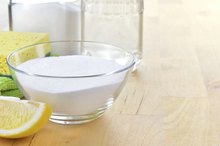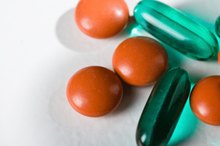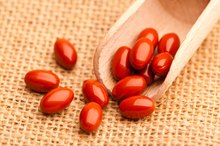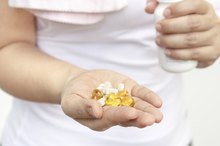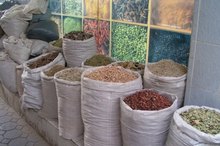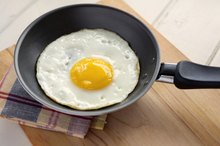Allergy to Vitamin B-12
Vitamin B-12 is taken in supplement form for people who lack the essential vitamin. An allergy to vitamin B-12 is uncommon but is possible. Drugs.com states that B-12 is important for cell reproduction, growth and blood formation. If you have a known allergy to cobalt or if you’ve been diagnosed with Leber’s disease, you should not take a B-12 supplement. If you develop adverse reactions after you ingest a vitamin B-12 supplement, call your doctor for an evaluation of your symptoms. Some reactions may be side effects rather than related to an allergy.
Allergic Reactions
To adequately diagnose an allergy, your doctor may recommend allergy tests to determine if your body creates certain antibodies, called immunoglobulin E, or IgE, according to the American Academy of Allergy, Asthma and Immunology. When you ingest the supplement, your body mistakes it as a dangerous substance and begins to defend against it with antibodies. Your immune system overreacts to the supplement and creates IgE antibodies that fight off the vitamin, resulting in the production of histamine. Histamine is a chemical in the body that causes inflammation in soft tissue, leading to most allergy symptoms.
- To adequately diagnose an allergy, your doctor may recommend allergy tests to determine if your body creates certain antibodies, called immunoglobulin E, or IgE, according to the American Academy of Allergy, Asthma and Immunology.
- Your immune system overreacts to the supplement and creates IgE antibodies that fight off the vitamin, resulting in the production of histamine.
Signs and Symptoms
Baking Soda & Vitamin C for Food Allergy
Learn More
A vitamin allergy will cause mild to severe symptoms shortly after consuming the supplement. Common signs and symptoms include headaches, itchiness, asthma, general fatigue, runny nose, skin rash, wheezing, sniffling and sneezing. You may also develop digestive complications, such as nausea, vomiting, diarrhea, cramping, gas and stomach pain. More severe symptoms include hives, difficulty breathing and swelling in the face, lips or tongue, according to Drugs.com. Call your doctor if you develop any of these signs or symptoms. A severe allergic reaction may lead to life-threatening anaphylaxis.
- A vitamin allergy will cause mild to severe symptoms shortly after consuming the supplement.
Side Effects Vs. Allergic Reaction
Signs and symptoms may not be related to an allergic reaction. Drugs.com states that common side effects from taking vitamin B-12 include chest pain, unusual warmth in the arms or legs, rapid weight gain, headache, weakness, dizziness, numbness, nausea, diarrhea, pain, swelling, redness, fever and upset stomach. To confirm a vitamin B-12 allergy, your doctor may perform a skin prick test to determine if your body creates IgE antibodies after being exposed to the suspected allergen.
Treatment
Can You Be Allergic to Vitamins?
Learn More
The most effective treatment for a vitamin B-12 allergy is to avoid consuming the vitamin. Your doctor may recommend incorporating foods that contain B-12 to avoid the need for a supplement.
Related Articles
References
- Drugs.com: Vitamin B12
- HealthTree: Vitamin and Supplement Allergies
- American Academy of Allergy Asthma & Immunology. Allergic Reactions.
- Kołodziejczyk K, Bozek A. Clinical Distinctness of Allergic Rhinitis in Patients with Allergy to Molds. Biomed Res Int. 2016;2016:3171594. doi:10.1155/2016/3171594
- American Academy of Allergy Asthma & Immunology. All About Allergy Testing.
- Bernstein IL, Li JT, Bernstein DI, et al. Allergy Diagnostic Testing: An Updated Practice Parameter. Ann Allergy Asthma Immunol. 2008;100(3 Suppl 3):S1-148. (Current as of Sept. 2019). doi:10.1016/S1081-1206(10)60305-5
- Carr S, Chan E, Lavine E, Moote W. CSACI Position Statement on the Testing of Food-Specific IgG. Allergy Asthma Clin Immunol. 2012;8(1):12. Published 2012 Jul 26. doi:10.1186/1710-1492-8-12
- Fonacier L, Bernstein DI, Pacheco K, et al. Contact Dermatitis: A Practice Parameter-Update 2015. J Allergy Clin Immunol Pract. 2015;3(3 Suppl):S1-39. doi:10.1016/j.jaip.2015.02.009
Writer Bio
Diane Marks started her writing career in 2010 and has been in health care administration for more than 30 years. She holds a registered nurse license from Citizens General Hospital School of Nursing, a Bachelor of Arts in health care education from California University of Pennsylvania and a Master of Science in health administration from the University of Pittsburgh.
